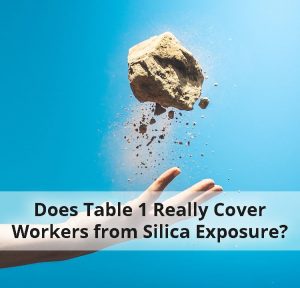The Occupational Safety and Health Administration (OSHA) is officially seeking industry input on the respirable crystalline silica standard for construction and general industry.
OSHA’s concern centers around Table 1 of the standard, which lists engineering and work practice controls designed to limit silica exposure. The administration requested comments on the effectiveness of current work practice controls, as well as other equipment and methods not currently listed in Table 1.
Related: Cabinet Manufacturer Cited for Silica, Hearing Violations
Furthermore, OSHA wants to gather information about potential scenarios where employees, who are covered by silica standards for maritime and general industry, must also comply with the standard for construction.
In addition to seeking information and comments from voices throughout the industry, OSHA also requested exposure data that could influence a revision of the standard.
Why Change the Silica Standard?
Table 1 of the silica standard provides detailed control measures, however, OSHA may have found that some workers can still be exposed to respirable crystalline silica dust despite those work controls.
The Department of Public Health and the University of Massachusetts Lowell conducted a study in early-2019. The department concluded that construction workers and bystanders are still at risk to respirable silica during certain activities — such as chipping and crushing.
Related: Will Mining Adopt a New MSHA Silica Standard?
Found in organic compounds such as rock, concrete, and brick, silica becomes respirable, or breathable, when released into the air. Silica also causes serious health damage, such as scarring lung tissue. Chipping and crushing activities release a high amount of silica.
Recently, a chipping worker was exposed to silica over the permissible exposure limit (PEL) 15 minutes into working, despite wearing a cartridge respirator. Workers who work with crushing machines usually exceed the PEL in under two hours.
In fact, according to IQPowerTools.com, one standard paver cut releases approximately 9 million micrograms of silica. That means that a single cut would release enough silica dust to meet the PEL for over 29 years worth of shifts.
Stay on Top of Silica
In addition to engineering and work practice controls, your best defense against silica is to establish a solid medical surveillance program. With Worksite Medical, that task is now easier than ever before with onsite medical testing.
Related: Breaking Down the Silica Physical Exam
Go mobile with silica physicals & respirator fit testing to increase productivity and lower the risks of off-site testing. Worksite Medical completes the physicals on-site – a medical history questionnaire, physical exam, chest x-ray, pulmonary function test, and TB test.
Complete the form below to schedule an appointment or request a quote, or call 1-844-622-8633.
If you’d like to provide input to OSHA for silica testing, submit your comments on or before Oct. 15, 2019.




